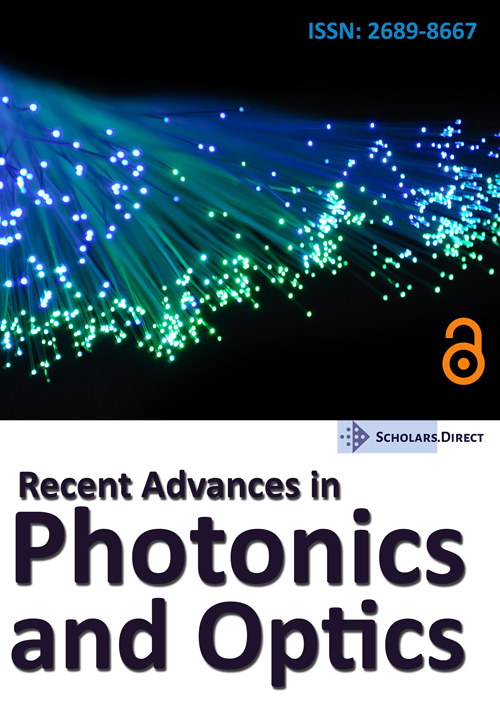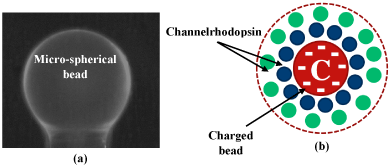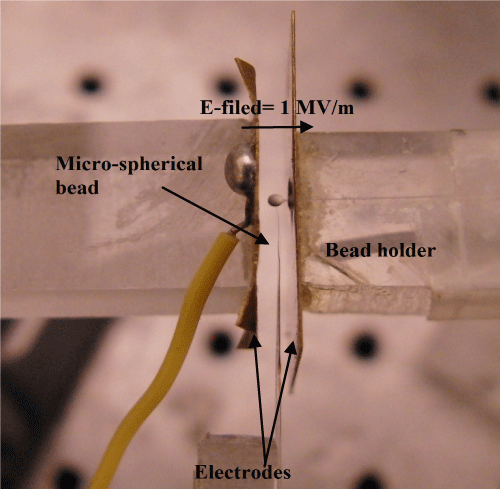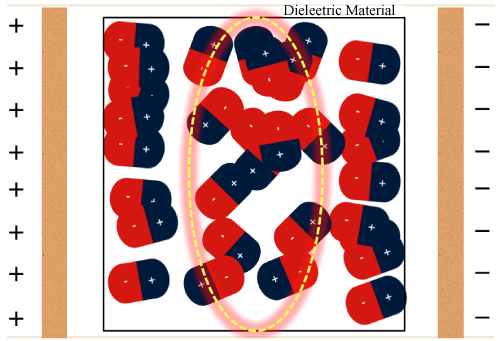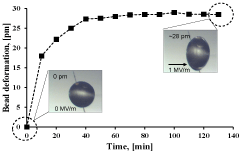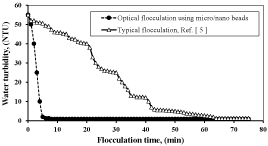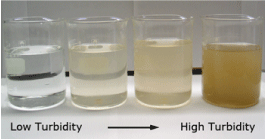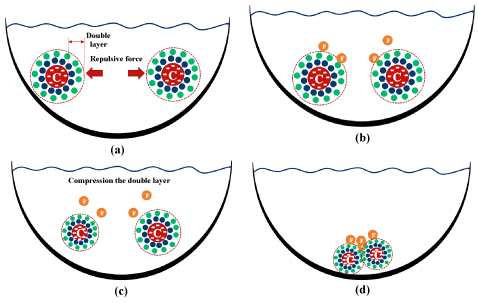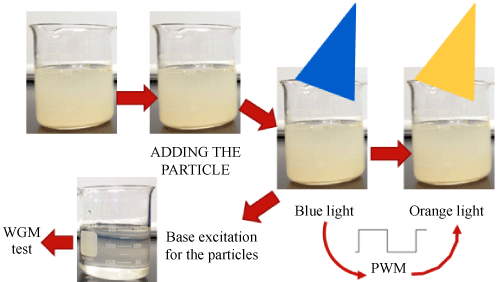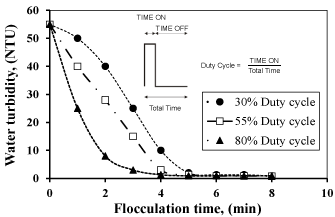Novel Optical Flocculation Approach for Chemical Contaminations in the Water Treatment Using Micro/Nano Polymeric Beads
Abstract
The optogenetic is a biological technique that involves the use of light to control cells in living tissue, typically neurons that have been genetically modified to express light-sensitive ion channels. In this paper, we exploit the use of the optogenetic to create a novel approach for water treatment and purification using a nano charged dielectric polymeric beads. In this approach, the beads will be coated with a photosensitive protein called channelrhodopsin. This protein is a subfamily of retinylidene proteins (rhodopsins) that function as light-gated ion channels. They serve as sensory photoreceptors in unicellular green algae, controlling phototoxic: Movement in response to light. The nano coated beads then poled for +4 hrs under 1 MV/m. When these nano charged beads mixed with water that have high turbidity, the beads starts to attract the colloids in that water. Since, the beads are coated with a photosensitive protein so by using a specific wavelength of the light we can control the motion of the spheres inside the water. Using a pulse width modulation (PWM) algorithm to control the speed of switching on/off the light; so it becomes easy to control the nano beads. The higher duty cycles for the PWM the charged beads makes the colloids aggregate and come together in a very short time (< 5 min) compared to the typical flocculation approaches that needs (~55 min). This approach is called an optical flocculation technique and it shows one order of magnitude enhancement in the flocculation time. Preliminary experiments were carried out to provide an assessment of this concept using more than one duty cycle to control the speed of the beads. Results shows that we can purify the drinking water in time less than 3 minutes under 80% duty cycle using this approach.
Keywords
Water treatment, Micro-optical beads, Channelrhodopsin, Optogenetic approach, Whispering gallery mode, Turbidity, Flocculation approach
Nano Charged Dielectric Beads
An understanding of the electrostatic properties of dielectric sphere has important consequences for many industrial processes and procedures [1]. Prime examples where electrostatic effects can have a significant influence on particle behavior include removal of fine particles and impurities from the drinking water.
Polymeric beads is manufactured using a ~5 cm long piece of optical fiber which is first stripped of its plastic cladding using an optical stripper and then heated and stretched to provide a stem end. The tip of this silica fiber is then dipped into a polymer pool [1]. Surface tension and the weight of the mixture allow for the formation of a spherical beads at the end of the stem as shown in the Figure 1a. Then, these beads will be coated with a photosensitive protein called "channelrhodopsin" as clear in Figure 1b.
To increase the surface charge of the micro/nano beads, it should poled for several hours at electric fields of ~1 MV/m. The electric field is generated by two brass plates connected to a high-voltage supply. The brass electrodes are shown in Figure 2.
Two metallic parallel-plate electrodes are used to generate the electric field. One plate is connected to ground and the other one is connected to a DC power supply (in the case of high electric field poling). The dielectric beads is placed in between the two electrodes and is subjected to the uniform E-field. The strength of the field can be adjusted by either changing the gap between the plates or varying the electric potential [2]. A schematic of this experimental setup are given in Figure 3 to show the segregation of ions.
The poling process is shown in Figure 4 where the bead is subjected to a field of ~1 MV/m. The deflection of the elastic bead increases over time under this constant external field indicating the increasing strength of the electrostriction force all over the surface of the bead is poled. As shown in Figure 4, after we impose ~1 MV/m, there is significant change in the morphology of the bead, indicating that a bead becomes very sensitive to attract the fine particles and impurities from the drinking water [3]. There is no significant change in the morphology of the bead after 45 minutes indicating that a saturation for the poling has been reached.
Optical Flocculation Approach
Suspended particle that are too light and small to settle are called "Colloids". These colloids cause a state of cloudiness, or haziness, known as "Turbidity". The more cloudy a fluid looks, the more turbid it is [4]. Toxic compound can adsorb, that stick to the surface of the suspended colloids. The more colloids there are the more toxic the water can become. Figure 5 shows the comparison between our new approach based on the optical flocculation versus the typical flocculation in Ref [5]. It shows that we can make the water with turbidity less than 1 NTU in less than 5 minutes by using this optical flocculation approach compared to the typical flocculation approaches that needs ~55 minutes to reach the same turbidity value for the water.
Flocculation is the process in which colloids aggregate, or come together, to form larger particles called flocs by addition of chemical called "flocculant" [6]. In turn, these particles will accumulate in the bottom of the beaker as you can see in the Figure 6 below and the water becomes clear when all larger particles precipitated in the bottom.
Figure 7 shows the same process described above but using the optical flocculation technique which using the nano charged spherical beads coated with the photosensitive protein called "channelrhodopsin". These beads will attract the impurities due to the poled beads will be under repulsive forces from each other's controlled by light. The channelrhodopsin will be activated the beads under blue light wavelength and make the beads move toward that wavelength. On the other hand, when we use an orange wavelength the coated beads with channelrhodopsin will kept without any movement as it could be seen later in the Figure 8. This kind a movement is like shaking the water, so by doing this movements back and forth that will leads to deposition the impurities on the surface of the beads.
So the recommended approach in this paper could be split to three stages. The first stage by adding the poled nano beads to the water that we need to treat using this optical approach. Then, by using a proper wavelength (blue and orange) through the PWM with 80% duty cycle we can assign an external force similar to the centripetal force acts on the spherical beads. Neglecting gravity, the body force due the centrifugal force acting on the bead can be written in terms of its radial and tangential component as follows:
Here is the density of the bead, and are unit vectors. When the bead rotates around an axis at a distance, e, then the centrifugal force acting at a point located on the center of the sphere will have directly proportional to the eccentricity.
Finally we can see all the colloids precipitated on the bottom and could be using the typical whispering gallery modes sensors to measure the water impurities.
There is a direct relationship between the speeds of turning the blue light to the orange light on the flocculation time to have water turbidity less than 1NTU. This speed will be known by the duty cycle. Figure 9 shows the direct relation between the less turbidity in a very short time.
Conclusion
In this paper, a sustainable solution for water treatment using an optical flocculation approach used for water treatment using the poled polymeric beads or powder. The optical approach based on the optogenetic technique is really promising to start a water treatment in less than 5 minutes compared to typical methods. The other WGM sensors based on optical resonance could enhance the feedback for whole process. Better results could be achieved when we using the more advanced controller for the PWM with 80% duty cycle, that will enhance the whole process. Also, enhancing the filtration process in the future using a high quality factor sensors.
References
- Ali AR, Ötügen MV, Ioppolo T (2012) High-resolution electric field sensor based on whispering gallery modes of a beam-coupled dielectric resonator. International Conference on Engineering and Technology (ICET).
- Eun-Gu L (2013) Effect of electrical field on the phase transformation of 0.7Pb(Mg1/3Nb2/3)O3-0.3PbTiO3 single crystals. Korean Journal of Materials Research 23: 329-333.
- Ioppolo T, Ayaz U, Ötügen MV (2009) Tuning of whispering gallery modes of spherical resonators using an external electric field. Opt Express 17: 16465-16479.
- Koohestanian A, Hosseini M, Abbasian Z (2008) The separation method for removing of colloidal particles from raw water. American-Eurasian J Agric & Environ Sci 4: 266-273.
- Tzoupanos ND, Zouboulis AI (2008) Coagulation-flocculation processes in water/wastewater treatment: The application of new generation of chemical reagents. 6th IASME/WSEAS International Conference on Heat Transfer, Thermal Engineering and Environment, Rhodes, Greece, 309-317.
- Hubbe M (2007) Flocculation and redispersion of cellulosic fiber suspension: A review of effects of hydrodynamic shear and polyelectrolytes. BioResourses 2: 296-331.
Corresponding Author
Amir R Ali, Mechatronics Engineering Department, Applied-Science & Robotics Laboratory for Applied-Mechatronics (ARAtronics Lab.), German University in Cairo, New Cairo, 11835, Egypt, Tel: +20-122-2257086.
Copyright
© 2018 Ali AR, et al. This is an open-access article distributed under the terms of the Creative Commons Attribution License, which permits unrestricted use, distribution, and reproduction in any medium, provided the original author and source are credited.

